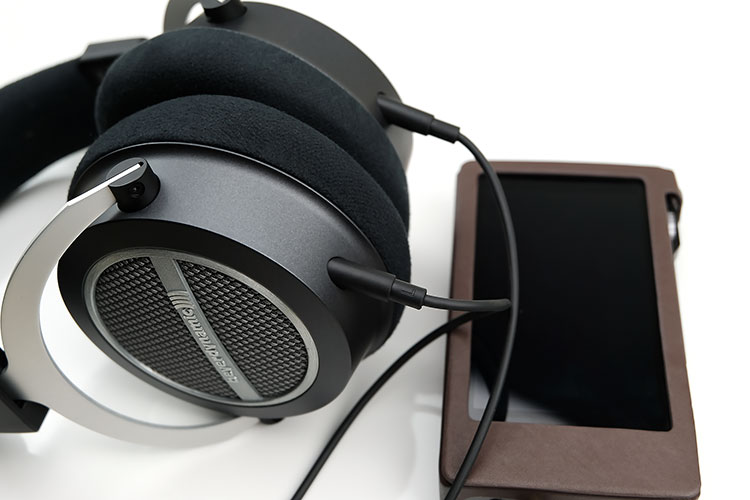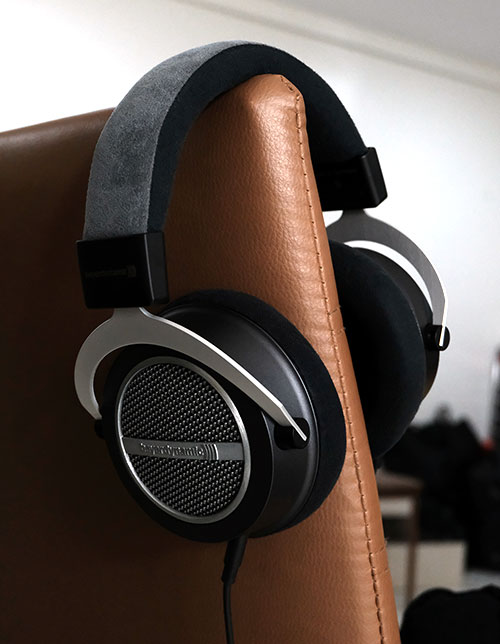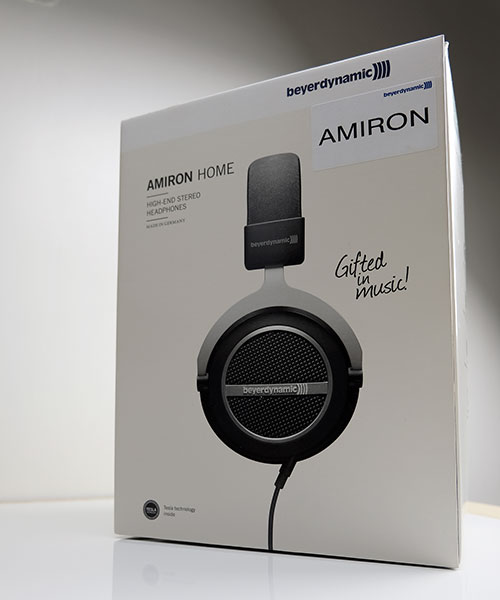Synergy
Efficiency
The Amiron Home is a 250-ohm headphone with a 102dB sensitivity rating. It will sound ok out of reasonably powered DAPs but it will sound much better with superior dynamics out of a decent headphone amp, be that portable or desktop.
Smartphones
Quality audio smartphones such as the Quad DAC LG G6 which has settings for 50-600 ohm headphones sounds reasonably ok, better than most phones I know. You will get decent voltage also with its digital volume sitting fine at 50 but the problem is the dynamics and extension compared to the better amped DAPs.
You lose a bit of the treble energy which some might prefer but you also get a very soft bass performance which most won’t. I tended to find the same results with the ZTE Axon 7 which left the treble a bit brittle and the bass wooly despite its spacious sound.
DAPs
With most DAPs, I found myself moving to medium gain or in some cases a high gain setting for voltage control as well as trying to inject a bit more aggression out of the Amiron Home low end which tends to get a bit polite and soft with weaker sources/amps. That is not to say certain DAPs won’t sound good, you simply want to get the best possible for the ohm rating of the Amiron Home.
DAPs such as the Alien+ and The Bit’s Opus#2 required generous amounts of voltage to drive the Amiron Home with the Opus#2 sitting around 115 out 150 for a comfortable volume setting and the Alien+ on mid gain setting and about 80% up on the rotary volume dial. They do however have better dynamics and resolution than the G6 and ZTE Axon 7 audiophile phones.
Noise will not be an issue out of any DAP or amp with the Amiron Home, it more a question of output power and voltage levels to drive it optimally.
Tonal Pairings
LG G6 (QDAC on)
Volume: 50
A little compressed sounding with less extension in either direction though retained its warm to neutral timbre, especially in the lower mids.
Still sounded competitive and a step up on other smartphones such as the Axon 7 but doesn’t have enough power to really drive the 250-ohm Amiron Home so the bass impact is warm but a little soft and lacking in definition and vocals fall away a little into the muddier layering.
Opus#2
Volume control: 115/150 high gain
Smooth, balanced sound with a polite but full sounding low-end, clean mids with good vocal spacing and not an overly aggressive treble response, very suited to soul, Motown, and RnB.
This was one of those flowing pairings that maybe didn’t get the fullest of sounds from the Amiron Home but tonally was a lot easier going than some of the more neutral or aggressive DAPs. The detail and control were excellent with a more natural to warm timbre.
AK380
Volume: 100 – 120
This is a fuller and more holographic sound than either the Alien+ or the Opus#2 with a little more smoothness and less neutral sounding than the Alien+.
I like the treble performance a lot on the AK380, it sounds more natural and less edgy especially with EDM such as Dash Berlin or even percussive heavy metal merchants Five Finger Death Punch. Vocals are clear and very well defined with plenty of space despite the v-shaped signature you never really feel vocals are struggling to make themselves heard.
The low end is full sounding but it’s a touch polite and lacking in impact compared to desktop amps.
Alien+
Volume: 80% on mid-gain or 50% high gain
This was a neutral and clean signature and a little more aggressive sounding than the Opus#2 and much more dynamic sounding than the smartphones previously tested. The Amiron Home low end was more responsive and the treble energy was just north of neutral and reasonably articulate.
This was a good match actually with EDM acts such as Justice and Benny Benassi where mid-range complexity and vocal prowess is not a must.
Amping
Amping will give you the best performance with the Amiron Home in terms of dynamics, bass impact, and offering the most pleasing treble performance. Tube amps produced the most pleasing top end but lack a little in energy and low-end impact compared to the solid-state pairings.
Vorzuge AmpDuo 2
Volume: 12 noon low gain
Source: AK380
Possibly my favorite portable amp pairing with no voltage issues and well driven even on low gain mode. You do get a little bit of a higher than needed noise floor on mid and high gain with some audible signal detected even in zero volume settings but no background hiss.
Tonally this is an excellent pairing with a full-blooded rich-sounding timbre, a fairly well-defined mid-bass response with good impact, and a treble response that is up there with the desktops with a smooth but clean and articulate response.
Vocals in particular sound engaging with good texture and very little sibilance even on breathy vocals such as Ellie Goulding. You do get a very slight metallic tinge but this more to do with that lower treble energy from the Amiron Home but it is less omnipotent on the AmpDuo 2 pairing.
ALO Audio V5
Volume: 3pm on low gain, 12 noon on high gain
Source: AK380
The V5 didn’t have too many issues driving the Amiron Home though it did sound a bit more comfortable on high gain as opposed to low gain though with much less volume wiggle on the pot. No audible signal could be detected, good channel balance, and no background hiss.
Tonally this is slightly different to the AmpDuo with a slightly more mid-centric focus and not quite as planted in the bass and lower mids with a slightly sweeter tube sound akin to the Studio 6 desktop but not quite as dynamic sounding.
Vocals are a bit more liquid sounding than the AmpDuo 2 though not quite as textured. Treble with the V5 is easier going and more natural sounding than the paired DAPs and slightly softer sounding than the AmpDuo 2. Overall this is a solid if slightly more laid back alternative to the AmpDuo 2 with the Amiron Home.
Cayin iHA-6
Volume: 9am
(Source – Oppo Sonica DAC)
This desktop pairing had a typically more solid-state sound than the Studio 6 smoother tube presentation so you will get a bit more low-end energy and power with the Amiron Home. It also has a cleaner attack and a slightly brighter lower treble response. Treble body though is good and despite its elevated energy I always felt the Cayin had it well under control.
Vocals on the Amiron Home are also a bit more forward sounding than the Studio 6 with the whole mid-range just that bit more vivid and energetic sounding.
ALO Audio Studio 6
Volume: 10am
(Source – NuPrime DAC-10)
Zero problems with power with a very controlled volume pot and no background tube hiss or noise issues.
This is a much smoother performance than the Cayin iHA-6 with a controlled treble that had plenty of sparkle without sounding distracting and very nice contrast indeed with the elevated mid-bass response.
This is not as aggressive sounding as the Cayin or even the DuoAmp 2, however, the Studio 6 sounded the most refined and was the easiest listening pairing with a forgiving top end and a more natural-sounding timbre.
Select Comparisons
This may come as a surprise but the T90 is one of the few Beyer headphones I have not tried or owned before and I have had quite a few though mainly closed so apologies if these are not exact fits but they should be useful benchmarks.
Beyerdynamic DT1770
SRP: $599
Technicality
The DT1770 is a closed headphone from their Studio Pro range and is also a 250-ohm rated can using a single entry 3-pin detachable single-ended cable. It does have a choice of cables, coiled or straight with quarter jack adapters if required as well as two sets of older style velour and pleather pads.
Like the Amiron Home the DT1770 scales up very nicely with amps and sources with good amping outputs but it won’t fall apart with weaker amps either.
Tonality
Power
Tonally the DT1770 is really set up more for studio mixing than the Amiron Home so its tuning is more niche. It also sounds a little darker and less spacious sounding than the warmer open design of the Amiron Home.
Sub-bass is more sustained and elevated on the DT1770 so you get a lot more low-end power and rumble. The power stays pretty darn good until around 100-250Hz where it dips, and dips pretty hard at that, before coming back up again and straight-lining again until around 2k.
Smoother
The Amiron is gentler by comparison with less sub-bass power, a more gradual mid-bass rise giving a warmer sheen than the DT1770, and dropping in a more linear fashion into the mids. The DT1770 has that big drop from 100Hz to around 250Hz giving fundamentals a slightly leaner sound than the Amiron and producing more separation between the low end and the mids.
Sparkle
The DT1770 also has a fairly pronounced dip around 4-6k unlike the Amiron which has a lot more energy in this are as well as a 2-3dB greater spike at 5-7k.
The Amiron will have a stronger percussive presence and lower treble energy but it sounds just a little more consistent than the roller coaster FR of the DT1770. The final octave both drop off but the Amiron dips a bit less so it will sound a bit airier with more headroom than the DT1770.
Beyerdynamic T70p
Street Price $260 (Amazon)
Technicality
This is the 32-ohm version from the T series and a closed headphone. Unlike, the DT1770 and the Amiron Home the T70p does not need a powerful amp to get the most out of it though you can opt for the T70 250-ohm version which for me has the slightly superior low-end response.
Both the DT1770 and the T70p clamp a bit harder than the Amiron and have shallower pads and not quite as comfy but still pretty competitive.
Tonality
Bass & Power
The big tonal difference between these two headphones is the tonal bias in the low end with the Amiron has a higher level of mid-bass elevation and better sub-bass presence. The T70p is flatter sounding, with no real mid-bass bump so quite the opposite in sound to the warmer Amiron.
If you need some solid fundamental tones then the T70p will fall a bit short compared to the Amiron and definitely way behind the DT1770. Instruments sound a bit leaner on the T70p with less authority. By the way, you can EQ the heck out of the T70p low end and it will respond but with varying levels of quality. It is quite something with an old Digizoid Zo2 in tow.
Mids are not quite as dipped as the Amiron but it is not as dynamic and spacious sounding and vocals, though accurate, are not as vivid and detailed sounding.
Treble Focus
Treble is also an area where there is a bit of contrast. The T70p has some big dips and peaks but the resulting sound for my ears is not that bad actually and not as splashy as you might expect.
There is a big dip around 4-6k and a shorter decay that takes a little energy out of that area for the T70p, unlike the Amiron which steps on the gas a bit more and has a lower treble presence. The T70p though, with its mid-bass drop and less low-end power though will sound perceptibly more treble-heavy.
Sennheiser HD650
$315
Technicality
The HD650 is a 300-ohm open back design and like the Amiron Home, it also needs a fairly good amp to drive them optimally.
Physically I prefer the Amiron, it feels much more durable with better quality materials and much more comfortable on your head than the HD650. Admittedly, the HD650 design is a bit old school and also its SRP is a bit lower than the Amiron Home though the street price is now around $315 plus taxes.
Tonality
Tonally I find the Beyer to be a bit more detailed and cleaner sounding than the HD650 though the HD650 has a bit more low-end substance and a slightly thicker note right throughout the mids. Both have a warmish low-end signature but the Beyer’s treble energy injects a touch more excitement and contrast than the HD650’s more laid-back treble response which falls away a bit more.
On the flip side, the HD650 is the more forgiving sounding in its treble performance with a more natural tone from its lower treble response and less sibilance than the Amiron. The HD650 has a slight veil on the vocal response compared to the better spacing around the Amiron’s vocals and doesn’t quite have the same level of instrumental layering and depth.
Ultimately if treble sparkle is not your thing then the HD650 is a good alternative but if you prefer a more vivid contrast between treble and bass and a bit more depth and layering in the mids then the Amiron is a good choice.
Our Verdict
The Amiron Home is a big step forward for Beyerdynamic without losing that traditional house sound that makes them unique. The Tesla driver project starts many years ago and still seems to be a never-ending process but with the Amiron I think they are heading in the right direction with an easier sounding tonal signature that will win more fans than the previous T series.
It is still built like a tank, still looks very much like a classic Beyer design, in some ways, this is an area they do not have to tinker with. And yet the comfort and fit are so much better now.
The pads and headband materials are excellent, very comfortable indeed though the open design will mean it is very much an indoor peace and quiet choice. The detachable cable system is much more sustainable than the 3-pin of the DT series and certainly more flexible than the non-detachable single entry of the T series.
The usual caveats apply though as it is not a home run in terms of tonality and pricing. At $599 SRP I get a feeling the street price will vary some on the Amiron and maybe even drop a bit.
At times this seems to be quite normal for Beyer cans as the months’ tick by from the original launch period. Tonally the treble will still troublesome but much less so than before, particularly with some quality amping.
Otherwise, if you are considering migrating from the older T series or simply wish to have an open back variant of the Beyer sound then the Amiron Home should sound like a definite upgrade and something worth considering.
Amiron Home Technical Specifications
- Transducer type Dynamic
- Operating principle Open
- Frequency response 5 – 40,000 Hz
- Nominal impedance 250 Ohms
- Nominal SPL 102 dB (1 mW / 500 Hz)
- T.H.D. < 0.05 %
- Sound coupling to the ear Circumaural
- Weight (without cable) 340 g
- Cable 3 m / double-sided / detachable
- Connection Gold-plated mini stereo jack (3.5 mm) & 1/4″ adapter (6.35 mm)









